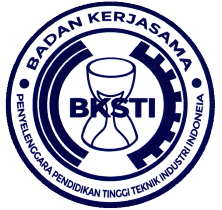Pemodelan Dinamis Proses Produksi Batch Satu Tahap Dalam Satu Mesin Dengan Memperhatikan Waktu Loading dan Waktu Proses
DOI:
https://doi.org/10.52759/inventory.v5i1.192Keywords:
Batch Process, Loading, Models, System Dynamics, UnloadingAbstract
In the batch process, the company uses the same process facilities to produce various types of products. This allows businesses to change production in response to changes in market demand. Batch processes are widely used in industry. In many cases, batch processes provide several benefits over continuous processes, especially when the industry wants to ensure and maintain the quality standards of its products. This paper proposes a behavioral model of a single-stage batch processing system, using the language of system dynamics. When run, the behavioral model will provide an overview of how the system behaves. The system dynamics language is a formulation of a system of ordinary differential equations that is extracted from the real system being studied, in the form of a stock and flow diagram. The computation of this diagram is further implemented using software. Because it is actually a calculus method, the system dynamics language provides output data much faster than discrete simulation modeling. In this paper, the system behavior modeled is mainly loading, processing and unloading activities. The verification results carried out by testing it on two different case examples show that the model can sufficiently describe the behavior of the conceptual system logically so that the model can enrich experimental tool options related to batch production processes in the future.
Downloads
References
I. K. Ramadhani, A. H. Halim, and A. S. Helmi, “Model Penjadwalan Batch pada Mesin Pemroses Batch Tunggal dengan Penjadwalan
Perawatan,” in Prosiding Seminar Nasional Teknik Industri (SENASTI), 2023, pp. 443 453.
L. Wang, Z. Lu, and X. Han, “Joint optimisation of production, maintenance and quality for batch production system subject to varying operational conditions,” Int. J. Prod. Res. Res., vol. 57, no. 24, pp. 7552 7566, 2019.
M. D. Astuti and A. H. Halim, “Model Penjadwalan Pada Batch Processor Tunggal Dengan Waktu Proses Total Waktu Tinggal Aktual,” J. Rekayasa Sist. Ind. Ind., vol. 4, no. 1, pp. 62 67, 2017.
F. Sarlinda, S. Sarto, and M. Hidayat, “Kinerja dan kinetika produksi biohidrogen secara batch dari sampah buah melon dalam reaktor tangki berpengaduk,” J. Rekayasa Proses , vol. 12, no. 1, p. 32, 2018.
P. Giudici, A. Baiano, P. Chiari, L. De Vero, B. Ghanbarzadeh, and P. M. Falcone, “A mathematical modeling of freezing process in the
batch production of ice cream,” Foods , vol. 10, no. 2, pp. 1 35, 2021.
M. S. Triyastuti, T. Finarianingrum, and T. Octaviani, “Validasi Model pada Pengeringan Batch Pada Wortel,” J. Tek. Media Pengemb.
Ilmu dan Apl. Tek. Tek., vol. 17, no. 1, p. 48,
M. P. Groover, Work Systems and the Methods, Measurement, and Management of Work. Pearson Prentice Hall 2007, 2007.
Tayfur Altiok, Analysis of manufacturing systems. New York: Springer Science + Business Media, 1997.
A. Jain, A. E. B. Lim, and J. G. Shanthikumar, “On the optimality of threshold control in queues with model uncertainty,” Queueing Syst. Syst., vol. 65, no. 2, pp. 157 174, 2010.
N. Laloue, F. Couenne, Y. Le Gorrec, M. Kohl, D. Tanguy, and M. Tayakout Fayolle, “Dynamic modeling of a batch crystallization process: A stochastic approach for agglomeration and attrition process,” Chem. Eng. Sci. Sci., vol. 62, no. 23, pp. 6604 6614, 2007.
P. S. Murdapa, “Modeling the Multichannel Section in the Supply Chain System using the Multiserver Queue Analogy,” J. Tek. Ind. Ind., vol. 23, no. 1, pp. 47 54, 2021
J. Forrester, World Dynamics. Massachusetts: Wright Allen Press Inc., 1968.
J. Sterman, Business Dynamics: System Thinking and Modeling for a Complex World. Irwin McGraw Hill, 2000.
J. Sterman, R. Oliva, K. Linderman, and E. Bendoly, “Syst em dynamics perspectives and modeling opportunities for research in operations management,” J. Oper. Manag. Manag., vol. 39 40, no. 15, pp. 1 5, 2015.
P. W. Anggoro, T. Yuniarto, B. Bawono, D. B. Setyohadi, P. S. Murdapa, and J. Jamari, “System dynamics modelling for calculation of carbon footprint on a non homogeneous production system: A case in a ceramic studio,” Results Eng.Eng., vol. 17, no. May 2022, p. 100812,
C. D. Indrawati and P. S. Murdapa, “Pemodelan Multi Channel dengan Lotsize Berbeda: Me nggunakan Pendekatan Kontinyu,” KONSTELASI Konvergensi Teknol. dan Sist. Inf. Inf., vol. 2, no. 1, pp. 71 79, 2022.
C. D. Indrawati, D. J. Pitoyo, and P. S. Murdapa, “Metodologi Pendekatan Sistemik: Metode Manajerial Mendasar Dan Powerful Yang Perlu Diimpl ementasikan,” JUSTER J. Sains dan Terap.Terap., vol. 3, no. 1, pp. 8 16, 2024.
Ventana, “Vensim Help,” 2019. [Online]. Available: https://www.vensim.com/documentation/21740.html . [Accessed: 09 Dec 2021].




